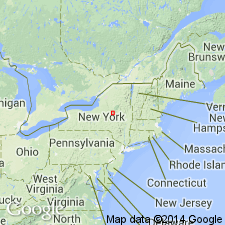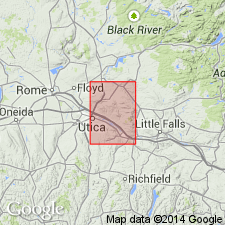
- Usage in publication:
-
- Steuben limestone member
- Modifications:
-
- Named
- Dominant lithology:
-
- [Calcarenite]
- AAPG geologic province:
-
- Appalachian basin
Summary:
Pg. 598, 601, 602. Steuben limestone member of Cobourg formation [of Trenton group]. Name proposed for upper member of formation in Utica quadrangle and vicinity. Described as coarse-textured calcite sandstone [calcarenite]. Maximum thickness about 60 feet; 26 feet exposed above dam on Steuben Creek. Overlies newly defined Rust limestone member; underlies Holland Patent shale. Age is Middle Ordovician (Mohawkian).
Typically exposed in small quarries and along streams south of road south of Steuben Creek for a mi from its mouth. Named from creek where exposed above dam at Prospect Bridge, Oneida Co., east-central NY.
Source: US geologic names lexicon (USGS Bull. 1200, p. 3720).

- Usage in publication:
-
- Steuben limestone member
- Modifications:
-
- Areal extent
- AAPG geologic province:
-
- Appalachian basin
Summary:
Pg. 61. Steuben limestone member of Cobourg Formation [of Trenton group]. Disappears by unconformity west of Poland [New York]. Outcrop areas described. Age is Middle Ordovician (Mohawkian).
Source: US geologic names lexicon (USGS Bull. 1200, p. 3720).
For more information, please contact Nancy Stamm, Geologic Names Committee Secretary.
Asterisk (*) indicates published by U.S. Geological Survey authors.
"No current usage" (†) implies that a name has been abandoned or has fallen into disuse. Former usage and, if known, replacement name given in parentheses ( ).
Slash (/) indicates name conflicts with nomenclatural guidelines (CSN, 1933; ACSN, 1961, 1970; NACSN, 1983, 2005, 2021). May be explained within brackets ([ ]).

